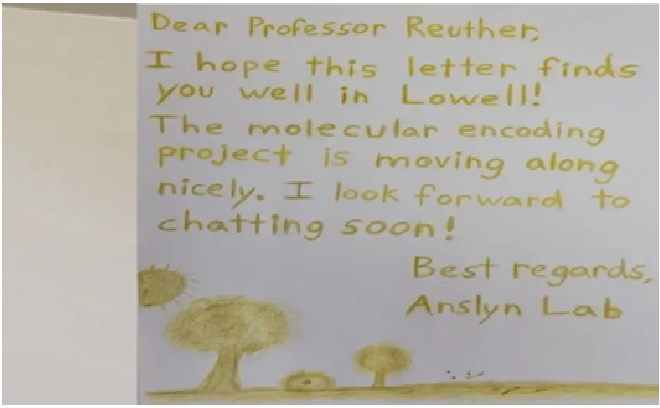A New Method to Decode Polymer Information Sequentially – Invisible Ink
Chemist Dr Eric Anslyn and his colleagues at the University of Texas at Austin developed a method to decode information from polymers in a sequential way so they can be read more easily. The process involves using liquid chromatography-mass spectrometry (LC/MS) – a method of reading chemical information.

Figure 1: Invisible ink with “Wizard of Oz” to read a digital file.
Figure 1 shows that researchers have been developing ways to store encryption keys in polymers, which are long chains of molecules, known as monomers, linked together. They can be artificial, like in plastics, or natural, like DNA helices. The problem is that the longer the polymer, the more difficult it becomes to work out what information is stored there. [1]
A technique that involves steganography – the practice of hiding one message inside another.The team generated a 256-character cipher key to encrypt and decrypt files using the Advanced Encryption Standard (AES), a common cryptography method. The group then encoded the cipher key into eight oligourethanes, a type of polymer.
“Because they’re a polymer with a very specific sequence, the units along that sequence can carry a sequence of information, just like any sentence carries information in the sequence of letters,” says Anslyn.
Each polymer was made up of 10 smaller compounds called monomers. The middle eight monomers hold the details of the key, with one monomer on each side acting as the key’s synthesizer and decoder.[2]
The eight coded pieces of information had to fit together in the correct order to unlock the binary key, and instructions on how to do this were stored in a monomer at the end of each polymer. Then the researchers mixed these eight polymers together and devised a step-by-step method of reading the polymers using LC/MS which, when followed, would reveal how they were originally designed and render the information codes available.
Finally, a group of researchers combined the polymers with soot and two colorless liquids – glycerin and isopropanol – to make an ink which they used to write a letter to other scientists who did not know the information. coded.
These scientists extracted the ink from the paper and followed the same sequence analysis created by Dr. Anslyn and his colleagues to reconstruct the 256-character binary key. When they entered this key into the algorithm, they found a plain text file of “The Wonderful Wizard of Oz”. [3]
References:
- https://www.studyfinds.org/invisible-ink-digital-file-wizard-of-oz/
- https://publicnewstime.com/news/tech/secret-ink-hides-full-text-of-the-wonderful-wizard-of-oz-in-a-letter/
- https://canttot.com/invisible-ink-is-taken-to-the-next-level-as-a-digital-file-with-wizard-of-oz-text-hidden-inside-the-letter/
Cite this article:
Sri Vasagi K (2022), A New Method to Decode Polymer Information Sequentially – Invisible Ink, Anatechmaz, pp. 377

